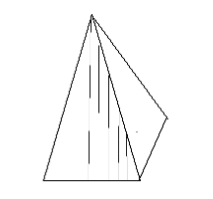 Picture A: The tent caterpillar has distinctive spines along its body. It also has colorful lines along its back and sides. The leaf on the lower side of the caterpillar has been partially eaten. Photo by Robert Dryja
Picture A: The tent caterpillar has distinctive spines along its body. It also has colorful lines along its back and sides. The leaf on the lower side of the caterpillar has been partially eaten. Photo by Robert Dryja
 By ROBERT DRYJA
By ROBERT DRYJA
Los Alamos
A sign of early spring is the growth of leaves on trees and shrubs. This early growth sets the stage for when an unusual species of caterpillar emerges. Ten to twenty tent caterpillars typically live together in groups. They build a distinctive silk thread tent around the branches of a shrub or tree. There are small holes in the tent for entering or leaving it.
The caterpillars gather into clusters that do not immediately look like a single caterpillar. The tent acts as a form of protection and a cluster of caterpillars do not look like an obvious meal. A bird therefore is less likely to peck its way in. A tent caterpillar also is covered with a coat of spines that discourages being eaten if it happens to be outside of a tent by itself.
The tents are a remarkable example of biological engineering. A caterpillar produces silken thread. A group of caterpillars connect their threads back and forth between small branches. A plant is selected as a source of leaves to eat as well as a place to build a tent. The resulting tent has a curvilinear geometric structure. None of the threads are wasted by hanging idly.
Picture B is an example of a tent that is approximately triangular in shape. A little math indicates the total length of threads created for the construction of such a tent. Consider a triangular shaped cone with four sides. Suppose it is nine inches long and three inches wide as shown in Diagram A. Each inch of width may have about fifteen silken threads running in parallel.
 Triangular Cone 9 inches tall with parallel threads and 3 inches wide. Courtesy/Robert Dryja
Triangular Cone 9 inches tall with parallel threads and 3 inches wide. Courtesy/Robert Dryja
 Picture B: A triangular shaped silken nest of threads has a group of caterpillars clustering toward the center. The caterpillars leave the nest by holes just large enough to pass through. Photo by Robert Dryja
Picture B: A triangular shaped silken nest of threads has a group of caterpillars clustering toward the center. The caterpillars leave the nest by holes just large enough to pass through. Photo by Robert Dryja
The following table shows that the caterpillars could make 945 linear feet of thread. And this is just for the outer layer of a tent. There are additional layers going to the center of a tent. If there are fifteen layers, then the caterpillars are making a grand total of 14,175 feet of thread. This is 2.7 miles. An actual tent may vary considerably from this grand total depending on its dimensions. However the math shows that the caterpillars may produce miles of silken thread.

The small diameter of a thread can be seen, so to speak, in an unusual way. A young caterpillar may appear to be floating in the air several feet above the ground, barely moving in any direction. A person can stand close to it but nothing can be seen for what is holding it up.
A clue is the tail of the floating caterpillar. The tail may be straight up while the rest of the caterpillar’s body is twisting and turning below. It looks as if a very small thread could be going up to a tree or bush above but cannot be seen. Sunlight may reflect from the thread from time to time, confirming that the caterpillar indeed is hanging by a thread.
Silken threads also are used to make guide paths to sources of food. A caterpillar leaves a thread along a branch as it explores for good leaves to eat. It adds a pheromone to this silken path when it finds such leaves. Other members of the group then can smell their way to them.
The change of a caterpillar into a moth or butterfly is remarkable. But also consider the remarkable length of the silken thread it can create; the diameter of this thread; and that it provides a guide to food.
 Picture C: A caterpillar becomes a brown colored moth when it matures in mid-summer. It lays eggs in a cluster in late summer. They emerge as a new generation the next spring. Courtesy/USDA Forest Service
Picture C: A caterpillar becomes a brown colored moth when it matures in mid-summer. It lays eggs in a cluster in late summer. They emerge as a new generation the next spring. Courtesy/USDA Forest Service

